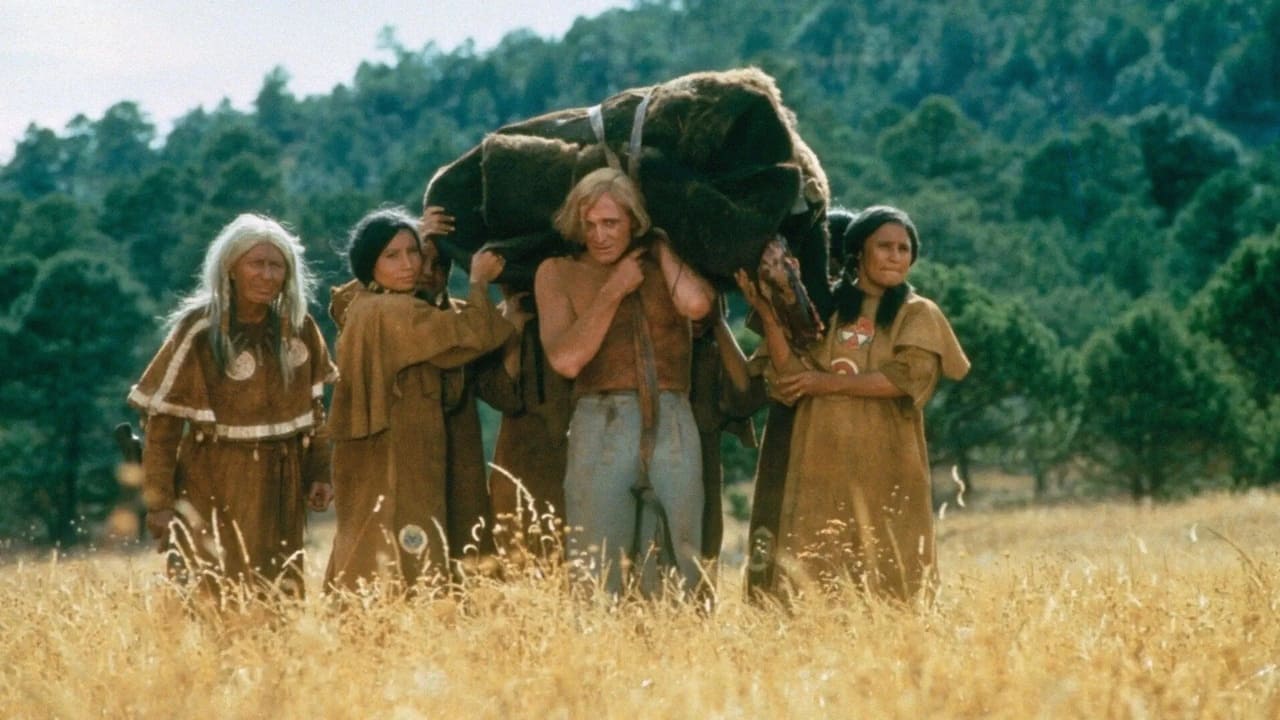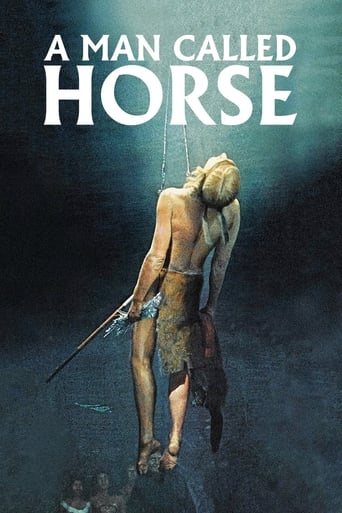



Masterful Movie
Lack of good storyline.
Excellent characters with emotional depth. My wife, daughter and granddaughter all enjoyed it...and me, too! Very good movie! You won't be disappointed.
View MoreThis is a gorgeous movie made by a gorgeous spirit.
View MoreIn the movie A Man Called Horse, there is many changes to the original story by Dorothy Johnson. One of the minor things changed was the names of the characters. This was a minor change to the story because in my opinion the names changed did not affect the plot and the overall message from the original story. Another minor change in the story was in the original book the Indian tribe Horse lived with were the Crow tribe but in the movie they were the Sioux tribe. I think this was minor because I don't think there were many differences between the tribes There were two major changes from the original story as well. One of them was the use of the character Baptise . In the Story by Dorothy Johnson, Baptise was only mentioned minor and did not play a major role in the book. But in the movie, Baptise had a huge role because he was the one who knew how to speak English and the Sioux language. This helped out the main character, Horse, as Baptise acted as a translator for him . Another major change in the story is they added was they added the sun vow and the sweat lodge scene. I felt this improved the story because it showed the process and ceremonies in detail how Horse became married to Running Deer which was left out in the original story .
View MoreAs a teacher I use Dorothy Johnson's short story (the basis for the script) as a piece of literature. I also show students most of this film, which amplifies a lot of the things that are only hinted at in Johnson's story--there is no substitute for actually seeing and hearing the chanting and drumming and dancing. In fact, simply the soundtrack, which in my estimation is about 90% drums or voice work, eschewing (until the last 20 minutes) the usual symphonic stuff, makes the film unique. The sheer intensity of the that piercing bone flute really does highlight how alien the culture and setting are to most viewers. So, as a piece of audio-visual enrichment, the movie does retain some cultural educational value, even if the entertainment aspect doesn't hold up against more modern films.We talk about the fact that the filmmakers did make an honest effort to portray what life might have been like in a Native village, from the location to the costumes, the attempts at language, the costumes, etc. It seems clear that somebody did do some background homework to try to make an authentic portrayal. It also seems clear that many actual historians (I am not) and people of Native descent, both of whose opinions I respect, find the film to be a mishmash of separate tribal practices that do not truly represent any one tribe. The love interest, Pretty Calf (called Running Deer in the film) is also obviously a European actress with manicured nails. Intentions do count for something, but well, not everything.That being said, it's certainly not any worse than the often low- budget stuff you'd find on the History Channel, though some of the effects (especially the ones involving violence) seem pretty fake and lame by the viewing standards of modern students. The Sun Vow ceremony does still hold up in the sense it gets strong reactions from students-- the make-up work and acting are such that it seems pretty realistic, much more so than any of the fight scenes.The DVD version I have includes all the things (largely nudity, and percentage-wise, mostly male nudity) that got the film an R-rating in 1970, so I do have to do a bit of fast-forwarding for my younger audience members, but there is nothing gratuitous about it, it is very tame by modern lights. The MPAA label says the R is for violence also, but there is way more, and more realistic violence in many current movies which only net a PG-13. I agree with other reviews that point out the double standards here.I would be remiss not to point out that the DVD print however is terrible, muddy and indistinct in many places, even for non-HD times. I have other DVDs of films from the era and none of them look this bad. If I hadn't worn out my VHS version I would still be using that.
View MoreThere are two ways to look a this film, the good direction, OK acting and some memorable scenes, then there is the other side, the bad costumes and obvious wigs, inaccurate history of the native Americans and the fact that almost every major native character is played by a white actor, even the female lead is played by a former Greek Miss Universe. I'm sure they could have found a pretty NA girl to play the simple role. This film is aching to be remade as a realistic example of the clash of cultures in the old west. The film can be forgiven for it's age and somewhat for it's inaccuracies for in 1970 movie making was crossing between the old style extravaganzas westerns and the young directors coming of age in the late sixties who wanted more realism.The story itself is very simple, there's not much character development at all and Harris's transition from captive to hero is a bit quick and corny. The director came from a TV background and a lot of the film has the feel of being episodic and rushed.
View MoreThe late great Richard Harris. (Not counting his foray into recorded pop music with MacAurther Park.) He was one the great English actors of his time. From "Camelot" where he played King Aurthur to this truly bold and gritty role as a privileged young Englishman,looking for more in his life than those "rights of inheritance". I got this movie (and it's sequel) from the library and watched both back to back.From the outset,this movie while set well over 100 years before 1970,reflected the young American point of view at that time of fighting the conventions and traditional beliefs of one's elders. Some may find that kind of idea dated but in my view there really is nothing more confining than living life as others "expect" you to and conform to the "norm".John (Harris) is unfortunately saddled with 3 typical uneducated,hard-drinking guides,who think of him as an English "dandy" and give him no respect. Going so far as to ruin his property while he's out hunting. Enter the Sioux/Yellow Hand tribe male warriors who,for seemingly no reason other than these are white men,attack and kill all but John.They fish an unclothed bathing John from the lake and (as the title implies) dub him a horse and drag him (literally)back to camp. He's taunted and harassed and made to be the work-horse of a cranky Sioux elder woman. Children even ride him during a wild party.Another man who was captured 5 years sooner and suffered even worse is the wonderful character Batiste. He speaks French, English and Siuox and behaves like he's lost his mind so the tribesmen would stop bothering him. Thus,he becomes the co-conspirator in helping "Horse" gain his freedom. John falls for the lovely Sioux girl he dubs "Little Freedom" and goes through a ritual guaranteed to make faint-hearted viewers cringe. The "Vow To The Sun",where sharp claws and hooks are attached to his chest and he's then hoisted by ropes through the open roof and spun around. This is a test in the ability to endure pain and suffering,sort of a metaphor for all the Native-Ameicans have suffered at the hands of people from other countries. John wins his bride but they still have to fight a warring rival tribe and the battle comes later. John ends up losing his closest friends and his wife and vows to be the son of the elder woman until she finally passes on. It's true a great deal of this is not factual,despite being about a real person. Hollywood has a notorious history of taking the background of other races and distorting who and what they're about. It's a little surprising here given they were trying to make a film that gives a better idea of what actual Indian tribes were like. Other than those unfortunate but hardly surprising missteps,this film "is" a classic and a great riveting story. I don't really see how one comes up "empty" after watching this film. Empty would be those ridiculous movies where Indians speak in that fake dialect dreamed up by Hollywood. "You smoke 'em peace-pipe?" Puh-lease!I give ten stars for this film because it is a great story to watch. Probably even a better one to read,since it is based on the book of the same name. Maybe I'll give that a read too. (END)
View More